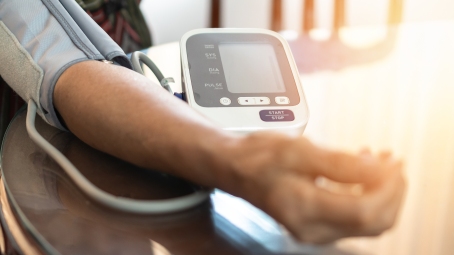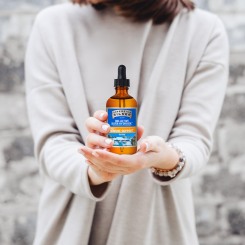Natural Approach to Hypertension
Contributed by Thorne Research

Hypertension. It’s one of the leading causes of disability or death due to heart attack, stroke, or kidney failure in this country. Heart disease and stroke remain the first and third leading causes of death, respectively. Expenses related directly or indirectly to the treatment and detection of hypertension approach $10 billion yearly.
Despite these facts, an estimated 50 million American adults (25% of all adults) have high blood pressure (BP), yet only 68% are aware of their condition and only 27% have it under control. Two million new cases are diagnosed each year. The risk of hypertension increases with age in both men and women. Before age 55, more men than women have it and the reverse is true for those over the age of 55. African Americans have significantly more risk of developing high BP than Caucasians and Mexican Americans. Disheartening statistics.
For most, optimal BP is 120/80 mm Hg or less. The systolic pressure (top number) measures the force that blood exerts on the artery wall as the heart contracts to pump blood, while the diastolic pressure (bottom number) measures the force when the heart relaxes to allow blood flow into the heart. BP is considered high when systolic blood pressure is greater than 130 or diastolic blood pressure is greater than 85.
In most cases of hypertension, proper vasodilation (relaxation of blood vessels) is compromised; a condition that requires the chemical, nitric oxide (NO). Produced by the cells in the lining of the blood vessels, NO secretes into the smooth muscles of the blood vessels, causing them to relax. If deficient in NO, blood vessels can become constricted, reducing blood flow and leading to high BP.
When blood flow is restricted, platelets may clump, inflammation and homocysteine levels increase, and it may even initiate the early stages of atherosclerosis, stroke, or congestive heart failure. Vessel stiffness and rigidity are also related to angina, erectile dysfunction, and peripheral vascular disease.
L-Arginine, a non-essential amino acid, is the precursor for the production of NO, therefore, necessary for healthy blood flow. Though it is produced by the body (i.e., “non-essential”), it appears that sufficient doses of L-arginine from food or supplementation are still required for adequate NO production. To ensure proper vasodilatory function, large doses of L-arginine, over sustained periods of time, are necessary. Although L-arginine reaches peak concentrations quickly, within an hour, both L-arginine and NO diminish rapidly, thus are no longer at effective levels.
A sustained-release formulation of L-arginine is found in Perfusia-SR from Thorne Research. This delivery method overcomes L-arginine’s tendency to spike and then diminish, by slowly releasing and maintaining consistent blood levels for longer periods of time.
Several studies have been conducted on L-arginine, one of which specifically reviewed the effects of Perfusia-SR on BP and blood vessel compliance. This study followed 29 participants with normal to mildly elevated blood pressure. A total of .1 g (1050 mg taken twice daily) of sustained-release L-arginine (perfusia) was taken for one week. Systolic blood pressure was reduced in 62% of all participants, all having a 4-point average reduction. Diastolic blood pressure was reduced significantly in 69% of all participants. In the 10 participants who were borderline or hypertensive, there was a significant 11-point average reduction in systolic pressure. Diastolic reduction was insignificant in this group.
There was also a significant increase in large artery compliance, meaning that the blood vessels became more elastic— an important effect since arteries that are stiff are more likely to be constricted, increasing BP.
In other studies, L-arginine was shown to improve blood flow. One study of participants with high cholesterol showed that 6.6 g of L-arginine daily significantly improved blood flow within one week. Several other studies showed it improved intermittent claudication (narrowed or blocked arteries, which cause pain in legs when exercising) and helped reduce pain when walking.
OTHER APPROACHES TO REDUCE HYPERTENSION
» MINERALS
Potassium is one of the most important minerals for hypertension. It is well documented that a diet low in potassium and high in sodium is associated with hypertension.
There have also been several studies indicating magnesium (Mg) may help lower blood pressure and may even prevent hypertension due to its relaxing effect on the smooth muscles of the blood vessels. A recent study showed that taking magnesium in amounts as low as 365 mg per day with beta blockers can significantly reduce BP compared to taking beta blockers alone. Thorne’s Magnesium Citrate provides an excellent source of highly available magnesium, offering 140 mg per capsule. To determine the appropriate dosage of magnesium, take increasing amounts of magnesium daily, only until it causes loose stools, and then decrease dosage by one capsule.
» OMEGA-3 FATTY ACIDS
Increasing your intake of Omega-3s can also lower BP. Recent research suggests that the Omega-3, eicosapentaenoic acid (EPA), signals blood vessel muscle cells to relax, resulting in vasodilation. In one study, participants with hypertension used omega-3 oils to reduce total cholesterol and blood pressure and increase HDL (good cholesterol).
» DIETARY
A diet low in saturated fat and high in complex carbohydrates is recommended. This diet includes whole grains, fruits, vegetables, nuts, seeds, legumes, fish, onions, garlic; is rich in potassium, calcium, and magnesium (carrots, spinach, alfalfa, mushrooms, lima beans, sweet potatoes, avocados, broccoli, and most fruits); and restricts salt.
» LIFESTYLE
More than one-third of the U.S. adult population is obese, presenting a significant risk factor for hypertension. Stress management and relaxation techniques such as meditation, can help control BP. One study found nearly 70% of patients with mild to moderate hypertension using stress-reduction techniques were able to lower their medications after six weeks; after one year, 55% required no medication.
Proper supplementation, as well as lifestyle changes, including diet, exercise, and stress management, has been used successfully. The message is clear: Relax … and avoid becoming a statistic.
Protect your Eyes Today to Help Defeat Vision Loss Tomorrow
By Kaori Dadgostar, Ph.D
The incidence of eye diseases among the aging population is on the rise, but a growing number of research studies have reported that many causes of vision impairment are preventable via proper diet and eye care.
The market for vision health supplements is on the rise. In 2008, US consumer sales for vision health supplements reached $331 million according to Nutrition Business Journal, and it continues to grow each year. This is probably due to our aging population and increasing understanding of ocular disease development and nutrition. Also, an increase in the use of computers and video games contributes significantly to public interest in vision health supplements.
Although the growing popularity of vision health supplements is probably a multi-factorial event, a recent economic downturn has played a significant role in increasing public interest in vision health supplements. More consumers are taking supplements as preventative care to minimize visits to health care professionals and cut medical costs. Many people have lost their healthcare benefits and access to conventional medical treatments due to employer budget cuts or loss of employment. Dietary supplements, including those for vision health, may help those people who already have compromised health to cope with their conditions while others may take them to avoid future complications. New developments in the national healthcare system have brought many doubts and uncertainties to consumers, and these have also led to a gain in the popularity of vision health as well as other dietary supplements.
Recent studies have shown the benefits of taking lutein and zeaxanthin for the prevention of age-related macular degeneration (ARMD), one of the leading causes of blindness in America. People who consume high amounts of lutein and zeaxanthin, either through diet or dietary supplements, have a reduced risk of developing ARMD by as much as 43%, while their macular pigment density, a critical factor in visual acuity, is significantly increased. Similarly, lutein and vitamin A supplementation can dramatically reduce the risk of retinitis pigmentosa, another cause of blindness. Further, lutein supplementation has been reported to enhance visual function during and after prolonged exposure to computers.
Look for an eye formula which provides a comprehensive combination of nutrients that support various aspects of eye health, including protection from UV radiation and free radicals, support for critical eye components like the lens and photoreceptors and the promotion of healthy eye circulation. Below are the recommended ingredients for vision support and their reported health benefits.
1. Lutein and Zeaxanthin are critical antioxidant carotenoids for the macula of the eyes. Dark green, leafy vegetables are good sources of lutein and zeaxanthin. Lutein and zeaxanthin reduce age-related increase in the lens’ density.
2. Blackcurrant Extract (Ribes nigrum) contains powerful polyphenol antioxidants that reduce eye fatigue and promote eye comfort.
3. Grape Seed Extract (Vitis vinifera) supports the strength of capillaries and other blood vessels in the eyes.
4. Alpha Lipoic Acid, Selenium, and Vitamin B2 support the antioxidants glutathione and glutathione peroxidase, which protect the eyes’ lenses.
5. Ginkgo Biloba Extract promotes circulation and contains potent free radical scavenging flavonoids known as ginkgo flavonglycosides.
6. Quercetin is an antioxidant that protects lens architecture.
Additional products that use unique technologies and formulation methods to support eye health are Bilberry and Carotene.
Bilberry offers standardized flavonoid antioxidants. Swedish bilberries contain 25% polyphenols as anthocyanosides. Red Grapeskin extract contains 30% polyphenols including 4% anthocyanins. These flavonoids support and protect vision by enhancing antioxidant status in the eye and reducing capillary permeability and fragility.
Beta carotene provides a source of vitamin A with no risk of toxicity. Lycopene is an antioxidant carotenoid extracted from tomatoes. Lycopene supports healthy prostate function and protects against damage from free radical singlet oxygen. Lutein is an antioxidant carotenoid that occurs in nature with zeaxanthin. Dietary lutein and zeaxanthin concentrate in the eye’s macula and lens and protect these tissues from oxidative stress.
Best to protect your eyes today to help defeat vision loss tomorrow!
The Most Important Supplements for Men
By: Laurel Sterling, MA, RD, CD/N, Nutritionist and Educator Carlson Laboratories

In our modern times of high stress, insufficient sleep, and unbalanced diets, it can be very difficult to maintain balance and achieve optimal wellness. Men are no different than women as far as having hectic schedules which can put quite a burden on the body. Some of the top health concerns for men are heart disease, cancer, prostate issues, and mental health. According to the US Centers for Disease Control and Prevention of 2011, the top four leading causes of death for men are heart disease, cancer, stroke, and diabetes. No matter where they are in their lives: 20s, 30s, 40s, 50s, 60s and beyond there are basic supplements all men need for overall general health. These include a men’s multi, omega-3s, additional D3 & K2, and probiotics. Beyond these core supplements, men should consider adding in others for extra support related to cardiovascular and prostate health.
The multivitamin should be a men’s multi which will typically have specific nutrients targeted for men’s needs. A good quality multi-vitamin-mineral can help ensure we are getting the RDA of important vitamins and minerals. It should contain enough B vitamins to assist with extra stress and energy demands. It will have nutrients more so targeted for cardiovascular and prostate health. A substantial amount of vitamin D3 and K2 as MK-7 should be part of the formula for heart health. Nutrients to support healthy prostrate function include vit E, zinc, and selenium. Blood sugar balancers like chromium, vanadium, and alpha lipoic acid are important as well. It would be excellent if a multi also provided us with some EPA and DHA too.
Beyond any omega-3s found in a multi, additional would be necessary for a variety of reasons. Omega-3s have an immense amount of research backing up how they support mood, memory, brain, nerve, vision, joint, cardiovascular health, and so much more. The American Heart Association and GOED (Global Organization of EPA and DHA) recommend 500mg for the general healthy adult population. We are now seeing 1-2g/day of omega-3s in research being beneficial and recommended for various health issues including cardiovascular support.
Typically, multi’s have 25mcg (1000IU) of vitamin D3, but we are seeing through research that we most likely need more. Vitamin D3 is incredibly important as it promotes healthy growth and development, supports teeth, bone, and muscle health, assists with a healthy immune and cardiovascular system, aids with healthier moods, and it is seen as beneficial in various cancer research. It is difficult to synthesize adequate amounts of vitamin D from sunlight due to restricting time out in the sun, sunscreens, latitude, time of year, color of skin, and more; therefore, supplemental vitamin D as an excellent and necessary addition.
Vitamin D3 is important for calcium transport and absorption, and vitamin K2 as MK-7 is critical along with D3 for the formation of a strong bone matrix and cardiovascular health. Without D3 and K2 calcium begins to deposit into arteries which begins to stiffen them, and eventually plaque forms over time which starts a chain reaction in the cardiovascular disease process. Most adult Multi-Vitamin/Mineral formulas have some vitamin D3, however, you don’t see any or much vitamin K in multi’s for various reasons. They are now putting K2 (as MK-4 and MK-7) in some cardiovascular formulas also. Most adult recommendations for MK-7 are around 45-180 mcg/d.
It has been found that anywhere from 70-80% of our immune system is located in our GI tract. Probiotics are beneficial bacteria located all throughout our body, but mainly housed in our intestines. These lactic acid bacteria promote gastrointestinal support, a healthy immune system, and much more. If we are depleted of these healthy bacteria, then the body cannot maintain homeostasis which is essential for good health. Be sure to look for formulas that provide a variety of strains of both Lactobacillus and Bifidobacterium.
As mentioned above, some men depending on their age and health status, may need extra support in certain areas. For cardiovascular health beyond extra D3 and K2 (MK-7), other nutrients targeted for cardiovascular health include a vitamin E (mixed tocopherol), CoQ10, and additional antioxidants.
Nutrients that can be added in beyond your basics regarding prostate health include vitamin E, zinc, selenium, and other antioxidants like lycopene, pterostilbene, and curcumin.
Men, like women, should take the basic core four supplements of a multivitamin/mineral, omega-3s, extra D3 & K2, and a probiotic. A men’s multi most likely will have some additional nutrients to support specific men’s health issues. In addition to those small amounts found in a multi, and the supplemental D3 & K2, omega-3s, and probiotics, they should consider adding in additional nutrients for extra support regarding cardiovascular, prostate, and other health concerns. Whether we start in our 20s or 60s, we can maintain or work to regain our health with a variety of lifestyle, nutritional, and supplemental changes! Be sure to keep up on the core basic supplements mentioned in order to keep up with the pace and demands of life!
Addressing the Sleep-Pain-Anxiety/Depression Connection
By Jennifer Palmer, ND, Director of Education for NEEDS
“A good laugh and a long sleep are the best cures in the doctor’s book” — Irish proverb

DO YOU SPEND MORE TIME THINKING THAN SLEEPING SOME NIGHTS? Several polls have found that over 50% of Americans have trouble sleeping at some point in their lives. Insomnia and sleep problems are so pervasive that we have both National Sleep Week (March 7th-13th) and World Sleep Day (March 18th) to draw attention to this issue. Despite the pervasiveness, we generally fail to prioritize sleep as much as we do exercise and nutrition, even though it is just as critical to achieving optimal health. Chronic poor sleep can impair the immune system, cognitive function, and mental health. Long-term sleep deprivation can even result in death, as demonstrated in mouse studies that show that as little as two weeks without slumber will lead to their demise.
And it is not just the number of hours that we lay in bed with our eyes closed that contribute to our wellbeing. The quality of the shuteye is equally important. During the night, we cycle through REM and non-REM sleep. REM is dreamtime, and the deepest sleep occurs during stage four non-REM sleep, with the first stage being the lightest when a person can easily be awakened. If you have ever been wakened from a deep sleep where it took several minutes to regain consciousness and determine where you were, you were probably roused from stage-four non-REM sleep. Non-REM is when the body restores itself and devotes energy to the immune system to keep us healthy. Sleep medications are effective at inducing sleep, but it is not non-REM restorative sleep. So it is important to try to improve sleep quality without long-term use of pharmaceutical medications.
Sleep issues are universal, but the causes, effects, and how we experience them vary widely. Difficulty falling asleep (defined as taking greater than 30 minutes), difficulty maintaining sleep, early morning wakening, and unrefreshing sleep are different ways insomnia manifests itself. The causes of sleep deprivation are numerous: stress (ranked number one), anxiety, depression, shift-changes at work, jet lag, medical conditions (such as pain, restless legs syndrome, sleep apnea, etc.), alcohol, drugs, caffeine, side-effects of pharmaceuticals, nighttime exercise, and low blood sugar, to name a few.
Volumes could be written about how to address the wide variety of sleep issues and their causes, so we will focus on a common triad of problems—the combination of sleep deprivation, pain, and depression. Fibromyalgia is a clear manifestation of this combination. All facets are interrelated; muscle pain contributes to poor sleep, and chronic pain and sleep deprivation leads to anxiety, loss of hope, and depression. It may not be clear which symptom came first when experiencing this triad, almost like the chicken vs. the egg question. The issues of neurotransmitter imbalances, Vitamin D deficiency, and low magnesium levels can all contribute to the pain-sleep deprivation-anxiety/depression triad. We offer solutions to addressing these three key issues.
Key Neurotransmitter Imbalances
One of the common underlying threads with the pain/ depression/ insomnia triad can be low serotonin. Serotonin is a neurotransmitter that is responsible for temperature regulation, mood, sensory perception, relaxation, and sleep modulation. Low serotonin can cause anxiety, depression, insomnia, and enhanced pain perception. This explains why SSRI medications, which elevate serotonin levels by preventing it from being metabolized, can be effective in alleviating depression and sleep disorders.
The body manufactures serotonin from amino acids 5-HTP, tryptophan, and vitamin B6. Tryptophan is converted to 5-HTP, which makes serotonin. Some people have greater success supplementing with 5-HTP, others do better with L-tryptophan, which is available topically or in oral form.
GABA is an inhibitory or calming neurotransmitter. By reducing anxiety, it can calm worrying thoughts that interfere with good sleep. Sublingual GABA is good to keep by the bedside if you tend to waken for long periods in the middle of the night, because it can be taken without water and won’t cause morning grogginess.
Vitamin D Deficiency
Vitamin D deficiency has been shown in several studies to be related to a higher incidence of depression, and some small studies found that high doses (and not low doses) of vitamin D3 could help alleviate symptoms. Vitamin D deficiency has become more pronounced in modern times as we spend much more time indoors and protect our skin with high SPF creams and clothing for fear of skin cancer. As D levels have declined over the years, depression rates have increased. There are some plausible connections between vitamin D and depression; there are vitamin D receptors in the brain, indicating vitamin D has an effect on the brain and the fact that vitamin D helps make tyrosine hydroxylase, which works on the pathway that converts tyrosine to serotonin ultimately. Although research on the topic is lacking, it would be sensible to check vitamin D levels in a person who is depressed. Serum D levels (25(OH)D) should ideally be at least 50 ng/ml.
Vitamin D receptors are also located in the sensory receptors of the nervous system, linking Vitamin D deficiency to cases of unidentified pain. Research has found higher incidence of vitamin D deficiency in patients with pain, and improvement of pain symptoms with vitamin D supplementation.
Although there haven’t been full-blown clinical trials conducted to prove that vitamin D deficiency is related to insomnia, there have been case reports. And with its strong association with two of the three parts of the triad, it is quite possible that resolution of vitamin D deficiency could improve sleep patterns.
Low Magnesium Levels
Magnesium has a role in hundreds of biochemical reactions that occur in the body.
It controls muscle relaxation; therefore, deficiency can result in stiff muscles and pain, as commonly seen in fibromyalgia. It makes ATP (energy), which is used by all tissues in the body, but especially the brain. Magnesium deficiency is also related to elevated anxiety. By relaxing the muscles and the mind, magnesium can improve sleep.
Conversely, sleep deprivation can lower magnesium levels. Magnesium deficiency can have a spiraling effect that hinders many bodily functions. Keep in mind that B vitamins help with proper utilization of magnesium, so a B complex formula can optimize magnesium performance. Magnesium citrate, glycinate, taurate, and chloride are all excellent forms of bioavailable magnesium.
We all recognize the refreshment that comes from a good night’s sleep, but imagine the possibility of an overall improved quality of life that may take place by following these three key tips. Here’s to helping you improve sleep, relieve pain, and overcome anxiety or depression!
What do you do to support your immune system on a daily basis?

A healthy diet, regular exercise and mental relaxation practices can play a role in supporting our health and well-being, yet our immune system can still benefit from a little extra support when confronted by daily challenges.
There are many exposures that challenge your immune system throughout the day, including toxins and pathogens that cause inflammatory responses within the body¹ or that disrupt the gut microbiome,² which plays a key role in a healthy immune system.
We are confronted daily with chronic environmental and dietary challenges, as well as physical and emotional stressors which can weaken our immune system’s response. Therefore, a need exists to support our immune system every day to defend our good health and well-being.
Sovereign Silver® for Daily Immune Support*
Daily use of Sovereign Silver Bio-Active Silver Hydrosol™ supports your immune system so you can confront the challenges we face every day.* Because of its unique form, Sovereign Silver Bio-Active Silver Hydrosol is safe* enough to use every day for immune support,* unlike other silver dietary supplements and colloidal silver which often suggest taking breaks after 10 to 14 days of use because of the form of silver in their products.
Most herbs that provide immune support are specified for that critical time of need when the immune system is already overcome, and they are not suggested for use as daily immune support. Not only can Sovereign Silver offer daily immune support* because of its unique form, it also has a unique mechanism of action and can be used with other herbal immune support for a complimentary and comprehensive offering at those critical times when more is necessary.
The Form Matters!
Bio-Active Silver Hydrosol is the ultimate refinement of colloidal silver. It is a dietary supplement with a unique mixture of positively charged silver ions and the smallest silver nanoparticles achievable. This mixture allows for a “1 – 2 Punch” delivery of bio-active silver to the body for steady immune support.* The first punch delivers bio-active silver ions which offers immediate support, followed by a second punch delivery of the smallest particles which are converted into more silver ions, resulting in a product that offers greater than 98% bio-active silver to the body.
Because Sovereign Silver offers the smallest particle size in a 10 ppm concentration with greater than 98% bio-active silver, it is easy for the body to absorb, utilize and eliminate. This is not the case with other colloidal silvers that consist of larger particles and often additional ingredients, such as proteins or salts, which offer as little as just 12% bio-active silver. Sovereign Silver Bio-Active Silver Hydrosol has just 2 ingredients, 99.999% pure silver and pharmaceutical-grade purified water and is safe enough to take every day for immune support!*
References:
1. https://www.medicalnewstoday.com/articles/248423.php
2. https://www.ncbi.nlm.nih.gov/pmc/articles/PMC5515271/
*These statements have not been evaluated by the FDA. This product is not intended to diagnose, treat, cure or prevent any disease.
A “Natural” Understanding of Inflammation and Disease
by Joseph C.Maroon, M.D. Recent medical research now confirms that the root cause of many chronic diseases, such as arthritis, heart disease, eczema, asthma, and cancer, are due to chronic inflammation that can affect every cell in the body. Even some unlikely brain-related conditions, such as ADHD, depression, and Alzheimer’s disease, are found to have an inflammatory component. Classically, we were taught that inflammation is the body’s natural response to internal or external attack and, therefore, a protective mechanism. But if unchecked or the source of the irritation persists, such as smoking, pollution, obesity, or an unhealthy diet, this inflammatory response can produce chronic pain, breakdown of cartilage and muscle, and increased blood clotting. It even may cause genetic changes leading to various cancers and other diseases.
Recent medical research now confirms that the root cause of many chronic diseases, such as arthritis, heart disease, eczema, asthma, and cancer, are due to chronic inflammation that can affect every cell in the body. Even some unlikely brain-related conditions, such as ADHD, depression, and Alzheimer’s disease, are found to have an inflammatory component. Classically, we were taught that inflammation is the body’s natural response to internal or external attack and, therefore, a protective mechanism. But if unchecked or the source of the irritation persists, such as smoking, pollution, obesity, or an unhealthy diet, this inflammatory response can produce chronic pain, breakdown of cartilage and muscle, and increased blood clotting. It even may cause genetic changes leading to various cancers and other diseases.
Based on this fact, medical treatments and prescription drugs have been developed for the sole purpose of blunting or blocking this potentially damaging inflammatory process. Despite the amount of time and billions of dollars spent, the current state of treatments often lack effectiveness and can many times even lead to serious complications, such as stroke and heart attack, as seen with the nowwithdrawn drug, Vioxx. Alternative research profiling natural and plant sources to treat inflammatory conditions, now shows that certain dietary supplements can reduce levels of the pro-inflammatory factors found in the body to a similar degree as many prescription drugs and with significantly fewer side effects.
Discovering this fact, as a practicing physician, I’ve experienced a dramatic shift in not only how I view inflammatoryrelated diseases, but also the concept of disease prevention. One of the best natural products available is fish oil or its major constituent, omega-3 fatty acids. Omega-3s are comprised of two main biologically “active” products: EPA (eicosapentaenoic acid) and DHA (docosahexaenoic acid). For over 30 years, EPA/DHA has been the subject of more than 7,000 scientific reports, including thousands of human clinical trials investigating cardiovascular disease, stroke, cancer, hyperlipidemia, Alzheimer’s disease, ADHD, and rheumatoid arthritis. Fish oil’s action has been found, among many other effects, to lower the body’s levels of the inflammatory factors, thereby blunting the inflammatory response.
Originally, the benefits of fish oil were discovered in native peoples, such as the Inuit Eskimos in the early 1970s, whose diet consisted of mostly fish. This population was found to have a very low rate of heart disease and stroke, which initiated research on omega-3s. Studies now confirm that these essential fatty acids benefit healthy people, those at high risk of vascular disease, and those who already have vascular disease.
CONSUMING FISH OIL AS A SUPPLEMENT AND/OR IN A FISH MEAL SHOWS:
- a decreased risk of arrhythmia
- reduced triglyceride levels
- a reduced growth rate of fatty plaque in the arteries
- slightly lower blood pressure
- improvements in arthritic pain, mood disorders, brain function, depression, autoimmune disease, and much more
Since 1996 and confirmed in 2002, the American Heart Association (AHA) recommends eating fish (especially fatty fish, i.e., mackerel, lake trout, herring, sardines, albacore tuna, and salmon) at least twice a week. While high in EPA and DHA, fish can also have significant concentrations of pollutants stored in their flesh. These pollutants can lead in some cases to toxicity from mercury, PCBs, and dioxin, that build up and settle in various tissues, causing serious health consequences. (For information on minimizing mercury accumulation, see “Trawling the Mercury from Fish,” in the October 2004 edition of Natural Health Connection.
The AHA also recommends eating tofu and other forms of soybeans, walnuts, flax seeds, and canola oil. These contain alpha-linolenic acid (ALA), which can be converted to omega-3s in the body (unless a person is lacking critical enzymes to complete that process). The cardiac benefits of omega-3s have been extensively studied and there is now a huge amount of research showing positive effects on hypertension as well as breast, prostate, and colon cancers, along with many conditions affecting brain function and development and skin and eye disorders. All effects are primarily related to the natural anti-inflammatory actions of EPA/DHA, which can lower the inflammatory molecules in the body and diminish the inflammation-related damage that can occur to blood vessels, brain cells, and other organ cells of the body.
When choosing a fish oil supplement, it is critical to find a high-quality product that has concentrated amounts of EPA/DHA and is purified of any potential toxins. Because almost all modern research on omega-3s has used concentrated doses of fish oil supplements, most health practitioners recommend omega-3s as a supplement with the general dose of 1 to 3 g of EPA/DHA per day. This eliminates most generic type supplements, leaving those products that are rich in essential fatty acids, great tasting, and guaranteed free of contaminants. In my practice and in my research, I use Nordic Naturals fish oils because they fulfill these important standards of purity and efficacy.
In summary, there is now strong scientific evidence that natural supplements, like the omega-3 fatty acids found in fish oil and their anti-inflammatory properties, can have substantial benefits for many medical conditions and diseases. It is important to know that natural products can and have passed rigorous clinical testing and offer an alternative to potentially expensive and occasionally dangerous prescription medications.
Restoring Optimal Thyroid Health:

Hypothyroidism, the most common type of thyroid disorder, occurs when the thyroid gland fails to produce enough thyroid hormone. According to the American Association of Clinical Endocrinologists, as many as 27 million Americans may have some type of thyroid disorder. Of that number, approximately half remain undiagnosed. Managing hypothyroidism requires a comprehensive understanding of its effects, its fluctuations, and the targeted nutritional strategies that can restore optimal thyroid function.
Thyroid 101:
The thyroid is located in the middle of the neck, just below the “Adams apple” or larynx. This gland utilizes iodine to make thyroid hormones, including thyroxine (T4) and triiodothyronine (T3). The thyroid is under the control of the pituitary gland, a small gland found at the base of the brain. If the levels of thyroid hormones drop too low, the pituitary gland produces thyroid stimulating hormone (TSH). TSH stimulates the thyroid to make more T3 and T4—raising their levels in the blood. When the pituitary gland detects increased levels of T3 and T4 in the blood stream, it then decreases its TSH production.
The pituitary gland gets its information in several ways. It is able to detect and respond directly to the amounts of T4 circulating in the blood, but it also responds to the hypothalamus, a region of the brain that releases its own hormone, thyrotropin-releasing hormone (TRH). This network of communication between the hypothalamus, the pituitary gland, and the thyroid gland is often referred to as the hypothalamic-pituitary-thyroid axis (HPT axis).
Once released into the blood stream, T3 and T4 are transported throughout the body to regulate numerous physiologic functions, including metabolism. In the case of hypothyroidism, the thyroid does not produce enough T3 and T4. Often, hypothyroidism is not diagnosed because the signs and symptoms are easily confused with other conditions, such as the natural aging process, menopause, or stress. Signs and symptoms of hypothyroidism include: fatigue, weakness, weight gain, coarse/dry hair, hair loss, dry/rough skin, memory loss, abnormal menstrual cycles, pallor, cold intolerance, muscle aches/cramps, constipation, depression, irritability, and decreased libido.
Often, individuals will have “normal” lab results, but may still be symptomatic. This is referred to as subclinical or sublaboratory hypothyroidism. Regardless of the severity of hypothyroidism, if left untreated, it can affect the cardiovascular system, reproductive system and other major organs.
Modern Day Influences:
Ultimately, hypothyroidism is due to an imbalance in the HPT axis. In most cases, the imbalance has multiple causes, including stress, excess hormones, and many other factors. The body is hardwired to respond a certain way to dangerous situations. This “fight or flight” response prepares the body to either run away from the danger (e.g., bear) or confront the danger (e.g., fight the bear). During these “fight or flight” responses, a hormone called cortisol is secreted in higher levels and is responsible for several stressrelated changes (increase in blood pressure, lower sensitivity to pain, etc.). After the perceived threat is gone, the body’s relaxation response is activated and cortisol levels return to normal. However, in modern times, the “fight or flight” response may be constantly activated and cortisol levels remain high.
Our modern day lifestyle and the chronic stress it produces can profoundly affect thyroid function. Studies have demonstrated that stress, no matter how induced, is capable of altering thyroid hormone levels. In addition, combining several different stressful factors (sleep deprivation, calorie restriction, and intense physical activity) has been shown to have a synergistic effect on thyroid hormone levels.
Exogenous hormones, such as HRT and xenoestrogens, have also been shown to interfere with thyroid function. A 2007 study suggests that the thiocyanate in tobacco smoke interacts with other substances to affect thyroid function—yet another reason to kick the smoking habit. Other factors that have been shown to affect thyroid function include insulin resistance, nutritional deficiencies, poor digestion, dysbiosis, goitrogens, genetics, and aging.
Supporting Thyroid Function: Safe, Natural Alternatives
When looking at optimizing thyroid function, we need to first look closely at such basic factors as diet, sleep, and stress reduction. Achieving the recommended 7-9 hours of deep sleep each night is crucial for overall health in general. Because stress plays such an integral role in thyroid health, individuals should look at incorporating stress-reducing practices into their daily routine, whether it’s taking a yoga class or just spending five minutes doing some deep breathing exercises. Another key to managing thyroid hormone production is to ensure the thyroid glands are well-nourished. However, the reality is that most individuals don’t get the recommended daily allowances of nutrients from their diets. Supplements can play an integral role, in conjunction with a healthy diet, in achieving optimal nutritional intake.
The Many Benefits of Berberine
 Berberine is a specific active phytochemical (plant chemical) which can be found naturally in many different plants, including Phellodendron amurense, Hydrastis Canadensis (best known as goldenseal), Mahonia aquifolium or Berberis aquifolium (also known as Oregon Grape), Rhizoma Coptidis, Coptis chinensis (known as goldenthread), and Berberis vulgaris (also known as barberry). Many of the plants which are rich in berberine are native to Asian countries and have been incorporated into Ayurvedic and Chinese medicine for hundreds or thousands of years. Berberine is most concentrated in the root and sometimes berries. Its bright yellow color is so rich that it can also be used as dye, known as “natural yellow 18”.
Berberine is a specific active phytochemical (plant chemical) which can be found naturally in many different plants, including Phellodendron amurense, Hydrastis Canadensis (best known as goldenseal), Mahonia aquifolium or Berberis aquifolium (also known as Oregon Grape), Rhizoma Coptidis, Coptis chinensis (known as goldenthread), and Berberis vulgaris (also known as barberry). Many of the plants which are rich in berberine are native to Asian countries and have been incorporated into Ayurvedic and Chinese medicine for hundreds or thousands of years. Berberine is most concentrated in the root and sometimes berries. Its bright yellow color is so rich that it can also be used as dye, known as “natural yellow 18”.
Berberine is extracted from plants to produce berberine hydrochloride or berberine sulphate. There is also a synthetic form of berberine which is sold as a medication in other countries for gastrointestinal benefits. Many of the research studies on berberine use the synthetic version; however, some scientists and doctors believe that berberine is best utilized by taking the whole herb rather than the isolated extract.
Benefits of Berberine
Regardless of which plant berberine is extracted from, it has the same actions. The research on berberine is impressive. For some medical applications, the therapeutic effects of berberine rival its pharmaceutical counterparts. This is especially true in the case of stabilizing blood sugar levels and treating intestinal infections with diarrhea.
One of the most interesting and important biochemical roles for berberine is its action on an enzyme called AMPK. AMPK is an abbreviation for “adenosine monophosphate-activated protein kinase”, which is an enzyme that triggers chemical reactions in the body and controls cellular metabolism. The role of AMPK is extremely important because it acts as a master switch which coordinates various biochemical pathways and functions in the body. Its function is akin to the thermostat in your house, which turns on the heat when it’s cold out and turns on the AC when it’s hot. AMPK also reacts to external factors; however, it controls many more functions than just temperature, such as glucose control and metabolism. Most of the processes that AMPK controls are directly or indirectly related to how fast or slow we age and how long we live. AMPK is sometimes called the longevity enzyme because it is involved in so many processes that determine our rate of aging!
AMPK and Oxidation
One critical factor of aging that AMPK influences is oxidation. Oxidation is a normal part of metabolism, but it can become excessive and get out of balance. During normal cellular metabolism, free radicals are created through the process of oxidation. Free radicals have the potential for causing cell damage unless antioxidants swoop in to neutralize them. When the antioxidant supply is low, too many free radicals are created, and the body has trouble keeping up with the neutralization process. Free radicals cause damage to cells and tissues, which can physically manifest as disease and impact any area of the body to cause atherosclerosis, joint pain, and a host of other conditions. AMPK is the master control which can come to the rescue and limit damage induced by free radicals.
AMPK and Blood Sugar Regulation
AMPK also helps regulate blood sugar. In a normal healthy state, after eating, insulin acts as the delivery system for glucose to go from the blood into cells, where it’s stored or made into energy (ATP). In an unhealthy state, such as with insulin resistance, the system is out of balance and blood sugar is poorly regulated. Insulin resistance means cells shut down the insulin delivery and prevent glucose from entering. By keeping the glucose floating around in the blood, blood sugar levels spike while cells starve, and tissues are damaged. AMPK comes to the rescue to counteract insulin resistance by enhancing blood sugar uptake into the cells. Balance is restored as the cells use glucose for energy and lower blood sugar levels.
AMPK also contributes to healthy aging by increasing antioxidant activity, preventing inflammation and limiting fat storage. By properly managing these key pathways, AMPK slows the aging process and enhances healthy functions, but when AMPK activity is diminished, the aging process accelerates, and visual signs become noticeable.
AMPK slows aging
Active AMPK may regulate the speed of aging, but ironically, as we age, AMPK loses sensitivity, and becomes less responsive to the usual triggers. Sadly, although we need AMPK more as we age, it is both less sensitive and less available. This is when it is helpful to have an “AMPK-Activator” on hand, and berberine is one of the best plant-based solutions available. A large number of human and animal studies have shown that berberine enhances AMPK activity, balances blood sugar, and acts as an antioxidant, just to mention a few of its powerful actions.
Berberine Absorption
Berberine on its own has a low rate of absorption. Some studies have investigated various technologies for enhancing it; however, one of the most simple and effective methods is to take berberine with the whole herb that it came from. Berberine extract is effective in doses of 500 mg 2-4 times daily.
References:
Ageing research reviews 11(2012): 230-41
Diabetes 55:2256-2264; 2006
Am J Physiol Endocrinol Metab 294: E148- E156, 2008
Diabetes Metab Syndr Obes. 2012; 5: 213–217
The Anti-Aging Solution
by Marcia Zimmerman, C.N. Our biological clock starts ticking at birth. Until 30 or so, we generally grow better as we age, and most tend to be well beyond 30 before beginning to experience signs of aging, which include skin wrinkling, hair graying, aches, pain, fatigue, reduced stress adaptation, lowered immunity, and vision loss. Though we may have to accept growing older, we don’t have to accept these signs as part of the aging process.
Our biological clock starts ticking at birth. Until 30 or so, we generally grow better as we age, and most tend to be well beyond 30 before beginning to experience signs of aging, which include skin wrinkling, hair graying, aches, pain, fatigue, reduced stress adaptation, lowered immunity, and vision loss. Though we may have to accept growing older, we don’t have to accept these signs as part of the aging process.
WHY DO WE AGE?
Free radicals are the primary cause of aging. These highly charged atoms, molecules, or compounds are missing one electron, making them unstable. Electrons normally pair up, but if enough external energy is supplied, i.e., ultraviolet light, one of the paired electrons may be “knocked off.” An atom with a single electron seeks a second, which it steals from a neighboring atom that must now gain its own electron. The process of electron swiping disrupts normal cellular processes, wreaking havoc and damaging cells. Electrons are easier to steal from some molecules, with DNA, fatty acids, and proteins—like those that comprise muscles and organs—being prime targets.
So how can we better help the body help itself? Since genetic expression can be moderated by our environment, this establishes a clear cause and effect between aging conditions, diet, and lifestyle. Consequently, you can take charge of your own aging process. The Anti-Aging Solution provides five steps that attack aging at its genetic roots by preventing free-radical damage to DNA, enhancing its repair, and reigning in runaway inflammation.
STEP 1 Lower cortisol by reducing stress
Cortisol—dubbed the age-accelerating hormone—affects every cell of your body and nervous central system, activating protective defense mechanisms to save your life. However, persistent elevation of cortisol, usually resulting from induced stress, disrupts homeostasis by interfering with hormone, immune, brain, and nerve function. High cortisol levels are directly related to:
• Collagen and elastin protein breakdown in skin, joint, bone, and muscle tissue
• Memory loss and nervous system damage
• Increased inflammation due to allergies, asthma, and arthritis
Taking frequent breaks throughout the day for stress relief through breathing, stretching, relaxation, and meditation will help lower cortisol.
STEP 2 Nourish genes by lowering sugar
The typical Western diet, which is loaded with white flour and refined sugars, quickly turns to glucose in the body. The ultimate result of a high glucose load is glycation—oxidized glucose that coats the surface of proteins, such as collagen, preventing them from functioning. Collagen is the most plentiful protein in your body—making up skin, blood, lymph vessels, joints, tendons, ligaments, and internal organs—and the one most affected by glycation. Aging conditions most linked to glycation include:
• Memory loss (sugar coating of brain cells)
• Clinical depression
• Skin wrinkling or sagging
• Impaired immune functions (damage to thymus gland, lymphatic tissue, and immune cells)
Eating an abundance of fruits and vegetables protects your genes and promotes health and longevity.
STEP 3 Exercising your genes
Before the 1950s, Americans didn’t worry much about getting enough exercise. They walked or rode bikes to work. Many worked long hours on farms or in factories, as did their children. Today, many spend the day in front of a computer, grab something quick to satiate hunger, then go home and watch TV until bedtime. Consequently, our lack of exercise is killing us. Add at least 20 minutes of stretching, strength training or aerobic exercise to your daily routine.
STEP 4 Avoid environmental toxins and protect hormone levels
Environmental contaminates, such as those found in fertilizers, plastics, herbicides, and wood and carpet materials, are called endocrine disrupters, which affect hormones in both men and women. According to Theo Colborn of the World Wildlife Fund in Washington, D.C., “Endocrine-disrupting chemicals can undermine neurological and behavioral development and subsequent potential of individuals exposed in the womb…It may be expressed as reduced intellectual capacity, impaired responsiveness to environmental demands, or a variety of other guises.”
STEP 5 Supplementing genes
Even with a dramatic change in diet, supplements containing concentrated forms of nutrients, usually from food sources, are needed to overcome the damaging effects of micronutrient deficiencies, pollution, radiation, and internally generated free radicals. Since vitamins and minerals are required to cofactor metabolic enzymes, micronutrient deficiencies can cause profound alterations in normal cellular function. Nutraceutical supplements can also amp up DNA repair capability—the bottom line in preventing most disease by reducing DNA damage.
KEY SUPPLEMENTAL NUTRIENTS
SULPHUR-CONTAININGANTIOXIDANTS
Cruciferous vegetables contain a family of sulfur compounds known collectively as glucosinolates, and include diindolymethane (DIM), sulforophane, calcium D-glucarate, and indole-3-carbinol (I3C). They have been standardized in extracts and numerous trials validate their anti-aging benefits, such as detoxification and hormone balancing.
MITOCHONDRIA DNA PROTECTORS
Oxidative damage to the mitochondrial DNA is the root of aging and its conditions. Coenzyme Q10 and alpha-lipoic acid (ALA) provide the most powerful protection. CoQ10 inhibits lipid oxidation in cell membranes, including the brain, and protects DNA from oxidative damage. It also stabilizes membranes and reconstitutes vitamin E as an antioxidant. ALA is active in protecting both lipids and aqueous cellular components, and may reverse memory loss by reducing DNA/RNA oxidation.
ESSENTIAL FATTY ACIDS
From an anti-aging perspective, EFAs alter metabolism, change cellular response, and affect cellular growth and differentiation. Benefits of EFAs are to modulate genetic expression of key metabolic enzymes and reduce DNA damage. Omega-3, 6, and 9s, or various combinations thereof, have been shown to provide cardiovascular, immune, brain, and nerve function benefits, as well as general anti-aging benefits to dry skin, brittle nails, and thinning hair.
Managing the Gut-Brain Axis
By Dr. Jen Palmer, Naturopathic Doctor (ND) & NEEDS Education Director Did you know that the gastrointestinal tract communicates with the nervous system? Believe it or not, it’s called the gut-brain axis and through recent research it’s been determined to be an incredibly important relationship for keeping the brain healthy. The gut-brain axis is complex and three primary mechanisms support communication within it: 1) nervous system communication,
Did you know that the gastrointestinal tract communicates with the nervous system? Believe it or not, it’s called the gut-brain axis and through recent research it’s been determined to be an incredibly important relationship for keeping the brain healthy. The gut-brain axis is complex and three primary mechanisms support communication within it: 1) nervous system communication,
2) hormone signaling, and 3) immune system mediators. The gut-brain axis has become a means for treating various diseases, such as diabetes, obesity, and neurodegenerative diseases, such as multiple sclerosis, Parkinson’s, and depression.
Serotonin, also known as the happy neurotransmitter, is key in preventing mood disorders. A lesser known fact is that a large percentage of serotonin resides in the gastrointestinal system, making it a huge component of the gut-brain axis. Serotonin regulates mood, sleep, and appetite. Depression is considered a deficiency of serotonin and the medications designed to treat depression are focused on increasing the availability of this neurotransmitter. People with Alzheimer’s disease and other neurodegenerative diseases have lower levels of serotonin transporters and, as a consequence, can also suffer from mood and sleep disorders. Serotonin is also believed to be neuroprotective and can protect the brain from damaging factors that could lead to Alzheimer’s disease.
It’s critical to maintain a healthy bacterial environment in the gastrointestinal tract, also known as the “microbiome”—in order to optimize serotonin levels. The microbiome influences the gut-brain axis and can be an effective part of keeping a healthy nervous system. The gastrointestinal tract helps support healthy neuronal development through its communication with the nervous system. But if the microbiome is off-kilter, meaning there is a lack of quantity, quality, and variety of the good bacteria, bad bacteria can take over and there is a potential for neurodegenerative diseases to develop.
Studies show probiotics are fundamental to maintaining a vigorous digestive tract and contribute to the foundation of good health. Of course, probiotics have demonstrated both immediate and ongoing positive health benefits for numerous chronic gastrointestinal conditions, including irritable bowel syndrome (IBS). Additionally, they have been shown to help prevent food and environmental allergies, as well as Candidiasis, and help to degrade toxins. There is even proof that some strains of probiotics bind mercury and other heavy metals, preventing their absorption into the body.
However, many contemporary lifestyle choices negatively impact the quality and quantity of beneficial bacteria in the gastrointestinal tract. Antibiotic use, a high-fat/low-fiber diet, and gastric acid-inhibiting drugs disrupt the healthy balance of bacteria and create an environment that favors the growth of pathogenic bacteria. Although probiotics are found in certain foods, such as yogurt and sauerkraut, their viability and amount may be questionable. Many people require a concentrated supply provided in broad spectrum probiotic supplements.
Consider these probiotic options to balance a healthy microbiome and improve your overall health and well-being!
The specific probiotics included in FLORASSIST® Mood have been shown to positively influence biochemical signaling between the gastrointestinal tract and the nervous system, with positive effects related to mood. It contains three billion colony-forming units of two probiotic strains supported by human clinical research to show improved mood—Lactobacillus helveticus strain R0052 and Bifidobacterium longum strain R0175. Human clinical research conducted on this dual probiotic combination demonstrated improvements in mood, reduction in perceived stress, and promotion of relaxation. Two daily capsules of FLORASSIST® Mood is all you need to promote relaxation and improve mood.
Flora Biotic Ultra contains 35 Billion CFUs, providing a broad spectrum of 14 different probiotic strains. Only one capsule per day is required, offering convenient dosing. All strains are specified and guaranteed, through laboratory validation, and only the strains listed are those found in the product. There are nine different Lactobacillus strains and four different strains of Bifidobacterium, creating a well-rounded formula. The addition of NutraFlora™ scFOS, a “short chain” fructo-oligosaccharide, provides nutrition for the microflora and promotes adhesion and growth in the intestinal tract. To maximize delivery of the beneficial bacteria to the intestinal tract, the vegetarian capsules are enteric coated to ensure survival through gastric acid. Disintegration tests are performed on every lot to ensure proper intestinal release.
RAW Probiotics Ultimate Care is a unique High Bifido formula which includes the clinically studied Replenish Blend making it your ultimate complementary probiotic to achieve balance – helping you repopulate your gastrointestinal tract with good bacteria. The small, easy-to-swallow capsule offers 34 RAW probiotic strains promoting flora diversity as found in nature. It provides protein digesting enzymes for added digestive support. Each high-potency RAW Probiotics formula contains a naturally diverse group of over 30 beneficial probiotic strains from Bulgarian yogurt and Eastern European wild kefir, guaranteed to arrive alive.
Primdophilus Original by Nature’s Way is backed by “True Guarantee”, meaning that 5 billion CFUs per vegetarian capsule is guaranteed for the entire shelf life. True Identity ensures only the strains listed on the label are found in the product, and true release enteric-coating ensures stomach acid survival and intestinal delivery.
Multiple strains of Lactobacilli, Bifidobacteria, and other beneficial probiotics help fortify and balance intestinal microflora and support immune health. They come in delayed-release, or enteric coated capsules that may be shelf stable or need refrigeration.
Reference: Cellular and Molecular Life Sciences October 2017, Volume 74, Issue 20, pp 3769– 3787. Microbiome, probiotics and neurodegenerative diseases: deciphering the gut-brain axis. Susan Westfall, Nikita LomisImen KahouliSi Yuan DiaSurya Pratap SinghSatya Prakash.
